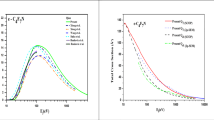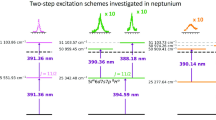Abstract
Context
The cyano propargyl radical (CH2C3N and HC3HCN) is important reaction intermediate in both combustion flames and extraterrestrial environments such as cold molecular clouds and circumstellar envelopes of carbon stars. The acquisition of spectroscopic constants and anharmonic effect facilitates a more in-depth study of this radical. However, the data available in the literature do not allow the precise predictions for it in the interstellar medium. In this work, complete spectroscopic parameters as well as anharmonic constants of two radicals of C4H2N have been evaluated by different DFT methods. The calculated results show that it is reasonable to study the molecular spectroscopic properties of C4H2N by wB97XD/6-311++G theoretical level. On this basis, the sextic centrifugal distortion constants, anharmonic constants, vibration-rotation interaction constants, and so on are predicted for the study of high-precision rovibrational spectrum. In addition, the relationship between the anharmonic effect and vibration mode of CH2C3N and HC3HCN and their infrared spectroscopic characteristics are discussed.
Methods
The calculation of the anharmonic force fields and spectroscopy properties was performed using B3LYP, B3PW91, CAM-B3LYP, and wB97XD methods combined with the 6-311++G and aug-ccpVTZ basis sets, respectively, by the Gaussian16 program suite. The IR spectra were performed with Multiwfn3.8.





Similar content being viewed by others
Data availability
The datasets generated during and/or analyzed during the current study are available from the corresponding author on reasonable request.
References
Cabezas C, Agúndez M, Marcelino N, Tercero B, Pardo JR, de Vicente P, Cernicharo J (2021) Discovery of interstellar 3-cyano propargyl radical, CH2CCCN. Astron. Astrophys. 654:L9
Chen W, McCarthy MC, Travers MJ, Gottlieb EW, Munrow MR, Novick SE, Gottlieb CA, Thaddeus P (1998) Laboratory detection of a new carbon chain radical: H2CCCCN. Astrophys. J. 492:849–853
Tang J, Sumiyoshi Y, Endo Y (2001) Laboratory observation of para-H2C4N. Astrophys. J. 552:409–412
Su H, Kaiser RI, Chang AHH (2005) A theoretical study for the reaction of vinyl cyanide C2H3CN (X1A') with the ground state carbon atom C (3P) in cold molecular clouds. J. Chem. Phys. 122:074320
Guo Y, Gu X, Zhang F, Tang MS, Sun BJ, Chang AHH, Kaiser RI (2006) A crossed beams study of the reaction of carbon atoms, C (3Pj), with vinyl cyanide, C2H3CN (X 1A')-investigating the formation of cyano propargyl radicals. Phys. Chem. Chem. Phys. 8:5454–5461
Singh A, Shivani AM, Tandon P (2014) Formation of cyanoallene (buta-2, 3-dienenitrile) in the interstellar medium: a quantum chemical and spectroscopic study. Res. Astron. Astrophys. 14:275–284
Cabezas C, Nakajima M, Chang CH, Agúndez M, Endo Y, Cernicharo J (2022) Laboratory observation and astronomical search of 1-cyano propargyl radical, HCCCHCN. Astron. Astrophys 657:A24
Kohn W, Sham LJ (1965) Self-consistent equations including exchange and correlation effects. Phys. Rev. 140:A1133–A1138
Frisch MJ, Trucks GW, Schlegel HB, Scuseria GE, Robb MA, Cheeseman JR, Scalmani G, Barone V, Petersson GA, Nakatsuji H, Li X, Caricato M, Marenich AV, Bloino J, Janesko BG, Gomperts R, Mennucci B, Hratchian HP, Ortiz JV et al (2019) Gaussian 16, Revision C.01. Gaussian, Inc., Wallingford CT
Becke AD (1993) A new mixing of Hartree-Fock and local density-functional theories. J. Chem. Phys. 98:1372–1377
Lee C, Yang W, Parr RG (1988) Development of the Colle-Salvetti correlation-energy formula into a functional of the electron density. Phys. Rev. B. 37:785–789
Becke AD (1988) Correlation energy of an inhomogeneous electron gas: a coordinatespace model. J. Chem. Phys. 88:1053–1062
Perdew JP, Wang Y (1992) Accurate and simple analytic representation of the electron-gas correlation energy. Phys. Rev. B. 45:13244–13249
Foresman JB, Frisch A (1996) Exploring chemistry with electronic structure methods. Gaussian Inc., Pittsburgh, PA
Srivastava R, Al-Omary FAM, El-Emam AA, Pathak SK, Karabacak M, Narayan V, Chand S, Prasad O, Sinha L (2017) A combined experimental and theoretical DFT (B3LYP, CAM-B3LYP and M06-2X) study on electronic structure, hydrogen bonding, solvent effects and spectral features of methyl 1H-indol-5-carboxylate. J Mol Struct 1137:725–741
Chai JD, Gordon MH (2008) Long-range corrected hybrid density functionals with damped atom-atom dispersion corrections. Phys. Chem. Chem. Phys. 10:6615–6620
Xu Q, Wang M, Liu Y, Chi L, Ma S, Li W (2020) Studies on spectroscopic constants for H2PO and D2PO free radicals. Chem. Phys. Lett. 754:137750
Li J, Wang M, Yang C, Ma M, Tong D (2015) Theoretical study of spectroscopic constants and anharmonic force field of SiF2. J. Mol. Model. 21:108
Barone V (2005) Anharmonic vibrational properties by a fully automated second-order perturbative approach. J. Chem. Phys. 122:14108
Zhu Z, Wang M, Yang C, Ma M, Liu W (2013) Density functional theory studies of spectroscopic constants and anharmonic force field of O35ClO. J. Theor. Comput. Chem. 12:1250117
Zhao Y, Wang M, Yang C, Ma X, Li J (2018) DFT calculations for anharmonic force field and spectroscopic constants of YC2 and its 13C isotopologues. Spectrochim. Acta. A. 191:382–388
Perdew JP (1986) Density-functional approximation for the correlation energy of the inhomogeneous electron gas. Phys. Rev. B. 33:8822–8824
Zhao Y, Wang M, Yang C, Ma X, Yu Y (2017) Computational anharmonic force fields of CuSH and CuSD. J. Phys. B. 50:155102
Clabo DA, Allen WD, Remington RB, Yamaguchi Y, Schaefer HF (1988) A systematic study of molecular vibrational anharmonicity and vibration-rotation interaction by self-consistent-field higher-derivative methods asymmetric top molecules. Chem. Phys. 123:187–239
Lu T, Chen F (2012) Multiwfn: a multifunctional wavefunction analyzer. J. Comput. Chem. 33:580–592
Code availability
Not applicable.
Funding
This work was supported by the National Natural Science Foundation of China (Grant No. 12274191) and the Natural Science Foundation of Shandong Province (Grant No. ZR2020MA079). All calculations were carried out at the Langchao Super Computer Center (LCSCC) of Ludong University.
Author information
Authors and Affiliations
Contributions
Xiaomin Song: writing—original draft, methodology, data curation. Meishan Wang: software, supervision, writing—review and editing. Yanliang Zhao: writing—review and editing, formal analysis. Chuanlu Yang: project administration. Xiaoguang Ma: writing—review and editing. Weixiu Pang: formal analysis. Yuanju Li: formal analysis.
Corresponding author
Ethics declarations
Consent to participate
Not applicable.
Consent for publication
Not applicable.
Competing interests
The authors declare no competing interests.
Additional information
Publisher’s note
Springer Nature remains neutral with regard to jurisdictional claims in published maps and institutional affiliations.
Supplementary information
ESM 1
(DOCX 660 kb)
Rights and permissions
Springer Nature or its licensor (e.g. a society or other partner) holds exclusive rights to this article under a publishing agreement with the author(s) or other rightsholder(s); author self-archiving of the accepted manuscript version of this article is solely governed by the terms of such publishing agreement and applicable law.
About this article
Cite this article
Song, X., Wang, M., Zhao, Y. et al. Molecular structure and spectroscopic properties of two radicals of C4H2N: a DFT study. J Mol Model 29, 56 (2023). https://doi.org/10.1007/s00894-023-05448-0
Received:
Accepted:
Published:
DOI: https://doi.org/10.1007/s00894-023-05448-0




